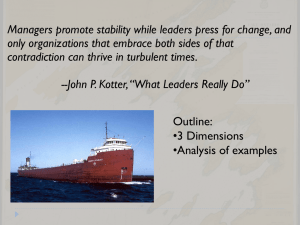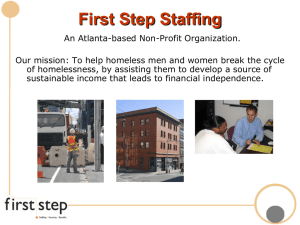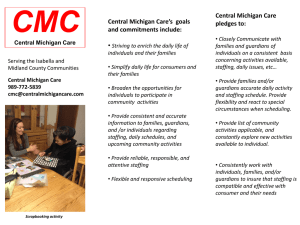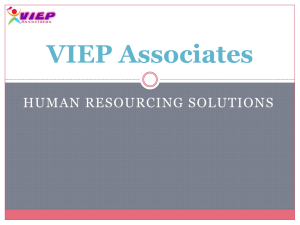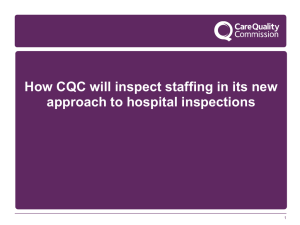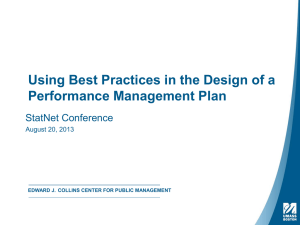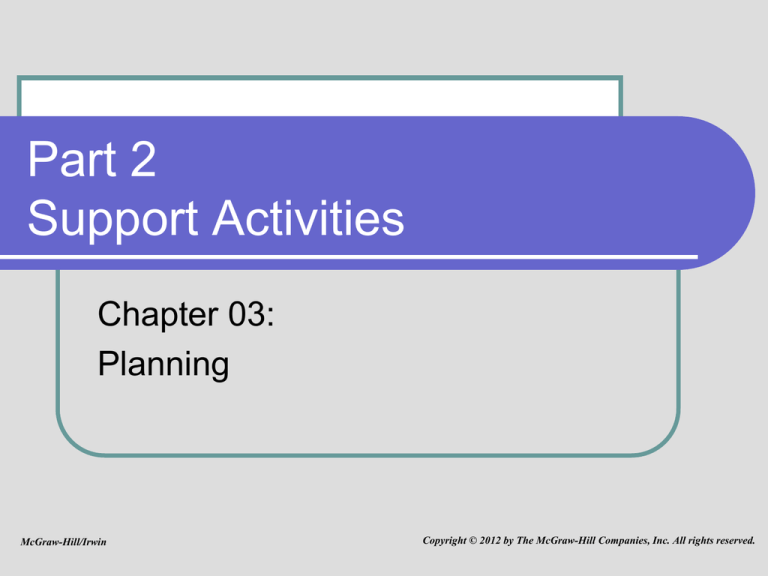
Part 2
Support Activities
Chapter 03:
Planning
McGraw-Hill/Irwin
Copyright © 2012 by The McGraw-Hill Companies, Inc. All rights reserved.
Staffing Organizations Model
Organization
Mission
Goals and Objectives
Organization Strategy
HR and Staffing Strategy
Staffing Policies and Programs
Support Activities
Core Staffing Activities
Legal compliance
Planning
Recruitment:
Selection:
External, internal
Measurement, external, internal
Job analysis
Employment:
Decision making, final match
Staffing System and Retention Management
3-2
Chapter Outline
External Influences
Economic Conditions
Labor Markets
Technology
Labor Unions
Human Resource Planning
Process and Example
Initial Decisions
Forecasting HR
Requirements
Forecasting HR
Availabilities
Reconciliation and Gaps
Staffing Planning
Staffing Planning Process
Core Workforce
Flexible Workforce
Outsourcing
Diversity Planning
Demography of the American
Workforce
Business Case for Diversity
Planning for Diversity
Legal Issues
AAPs
Legality of AAPs
EEO and Temporary
Workers
3-3
Learning Objectives for This Chapter
Recognize external influences that will shape the planning
process
Understand how strategic plans integrate with staffing plans
Become familiar with statistical and judgmental techniques
for forecasting HR requirements and availabilities
Know the similarities and differences between replacement
and succession planning
Understand the advantages and disadvantages of core
workforce, flexible workforce, and outsourcing strategies for
different groups of employees
Learn how to incorporate diversity into the planning process
Recognize the fundamental components of an affirmative
action plan
3-4
Discussion Questions for This Chapter
What are ways that the organization can ensure that KSAO
deficiencies do not occur in its workforce?
What are the types of experiences, especially staffing-related
ones, that an organization will be likely to have if it does not
engage in HR and staffing planning?
Why are decisions about job categories and levels so critical to
the conduct and results of HRP?
What are the advantages and disadvantages of doing succession
planning for all levels of management, instead of just top
management?
What is meant by reconciliation, and why can it be useful as an
input to staffing planning?
What criteria would you suggest using for assessing the staffing
alternatives shown in Exhibit 3.14?
What problems might an organization encounter in creating an
AAP that it might not encounter in regular staffing planning?
3-5
Ex. 3.1: Examples of External
Influences on Staffing
3-6
Labor Markets: Demand for Labor
Employment patterns
Demand for labor is a derived demand
Job growth projections
Employment growth projections
KSAOs sought
KSAO requirements
Education levels
Survey of skill deficiencies
Critically required skills
3-7
Labor Markets: Supply of Labor
Trends in supply of labor
Quantity of labor - Exh. 3.2: Labor Force Statistics
Labor force trends relevant to staffing
Growth
KSAOs
Demographics
Other trends ???
KSAOs available
Educational attainment
Literacy
Motivation
3-8
Labor Markets: Other Issues
Labor shortages and surpluses
“Tight” labor markets
“Loose” labor markets
Employment arrangements
Full-time vs. part-time
Regular or shift work
Alternative employment arrangements
Exh. 3.4: Usage of Alternative Employment
Arrangements and Contingent Workers
3-9
Technology
Reduces demands for some jobs
Replacement for labor
Makes products or services obsolete
Increases demands for others
Change in market composition
New product development
Changes in required skills
3-10
Labor Unions
Trends in union membership
Percentage of labor force unionized
Private sector unionization rate
Public sector unionization rate
Contract clauses affecting staffing
Impacts on staffing
“Spillover effects”
3-11
Labor Unions: Contract
Clauses Affecting Staffing
Management rights
Jobs and job structure
External staffing
Internal staffing
Job posting
Lines of movement
Seniority
Grievance procedure
Guarantees against discrimination
3-12
Discussion Questions
What are ways that the organization can
ensure that KSAO deficiencies do not occur in
its workforce?
What are the types of experiences, especially
staffing-related ones, that an organization will
be likely to have if it does not engage in HR
and staffing planning?
Why are decisions about job categories and
levels so critical to the conduct and results of
HRP?
3-13
Overview: Human
Resource Planning
Process
and Example
Initial Decisions
Forecasting HR
Requirements
Forecasting HR Availabilities
Reconciliation and Gaps
3-14
Ex. 3.5: The Basic Elements
of Human Resource Planning
3-15
Ex. 3.6: The Basic Elements
of Human Resource Planning
3-16
HRP: Initial Decisions
Strategic planning
Comprehensiveness
Linkages with larger organizational mission
Planning time frame
Job categories and levels
What jobs will be covered by a plan?
Head count (current workforce)
Roles and responsibilities
3-17
HRP: Forecasting HR Requirements
Statistical techniques
Exh. 3.7: Examples of Statistical
Techniques to Forecast HR Requirements
Judgmental techniques
“Top-down” approach
“Bottom-up” approach
3-18
HRP: Forecasting HR Requirements
3-19
HRP: Forecasting HR Requirements
3-20
HRP: Forecasting HR Requirements
3-21
HRP: Forecasting HR Availabilities
Approach
Determine head count data for current
workforce and their availability in each job
category/level
Statistical techniques
Markov analysis
Limitations of Markov analysis
3-22
Ex. 3.9 Use of Markov Analysis to
Forecast Availabilities
3-23
Exhibit 3.10 Replacement Chart
3-24
Exhibit 3.11 Succession Plan
3-25
Human Resource Planning
Reconciliation and
Gaps
Coming to grips
with projected gaps
Likely reasons for
gaps
Assessing future
implications
Action Planning
Set objectives
Generate
alternative activities
Assess alternative
activities
Choose alternative
activities
3-26
Ex. 3.12: Operational Format for
Human Resource Planning
3-27
Discussion Questions
What are the advantages and
disadvantages of doing succession
planning for all levels of management,
instead of just top management?
What is meant by reconciliation, and why
can it be useful as an input to staffing
planning?
3-28
Staffing Planning Process
Staffing objectives
Quantitative objectives
Qualitative objectives
Generate alternative staffing activities
Staffing alternatives to deal with employee
shortages and surpluses
3-29
Ex. 3.14 Staffing Alternatives to Deal With
Employee Shortages
3-30
Ex. 3.14 Staffing Alternatives to Deal With
Employee Surpluses
3-31
Discussion Questions
What criteria would you suggest using
for assessing the staffing alternatives
shown in Exhibit 3.14?
3-32
Exhibit 3.15 Internal Versus External Staffing
3-33
Staffing Planning: Flexible
Workforce
Advantages
Disadvantages
Two categories
Temporary employees
Staffing firms
Exh. 3.16: Factors to Consider When Choosing a
Staffing Firm
Independent contractors
3-34
Staffing Planning: Outsourcing
Advantages
Disadvantages
Special issues
Employer concerns regarding working
conditions
Loss of control over quality
Offshoring
3-35
Diversity Planning
The American workforce is highly diverse
Women make up ½ the labor force
Immigration
Civil Rights Legislation
Age
Business case for diversity strategies
Expanded talent pools
Better understand diverse customer base
Enhance creativity of teams
Reduce turnover
3-36
Diversity Planning
Planning for diversity
Recruiting activities
Selecting schools and colleges to recruit from
Show commitment to diversity in recruiting
efforts
Selection activities
Eliminate requirements not related to job
performance
Include objective standards for judging
candidate qualifications
3-37
Legal Issues
Affirmative Action Plans (AAPs)
Guidelines for AAPs
Purpose is remedying past discrimination.
Definite underutilization of women and/or minorities
Should not penalize majority group members
Should be eliminated once goals have been
achieved
All candidates should be qualified
Include organizational enforcement mechanisms
EEO and temporary workers
3-38
Ex. 3.18 Comparing Incumbency to
Availability
3-39
Discussion Questions
What problems might an organization
encounter in creating an AAP that it
might not encounter in regular staffing
planning?
3-40
Ethical Issues
Issue 1
Does an organization have any ethical
responsibility to share with all of its employees the
results of its forecasting of HR requirements and
availabilities? Does it have any ethical responsibility
not to do this?
Issue 2
Identify examples of ethical dilemmas an
organization might confront when developing an
affirmative action plan (AAP).
3-41




